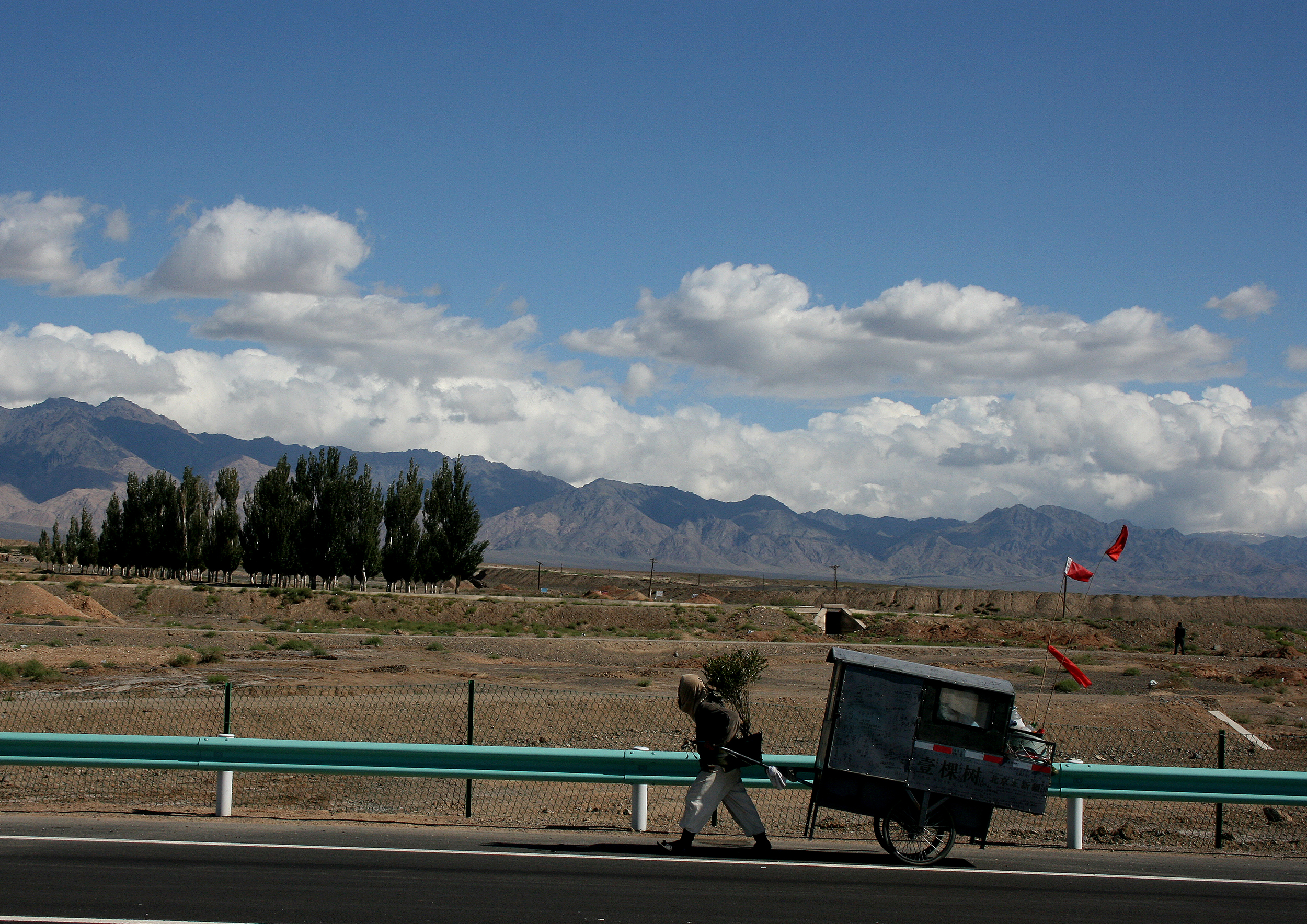 |
|
A Tree in Hami wind zone, Xinjiang |
 |
|
A Tree in Hami wind zone, Xinjiang |
From May 4 to September 16, 2012, Sazi carried a tree on his back and sleep rough while walking from Beijing to Urumqi, Xinjiang, covering around 3,800 kilometers without taking any other means of transportation. Every seven days, he would stop for one or two days to do laundry, charge the batteries, and sort images and textual materials.
Sazi was born in 1975 at the foot of Tian Mountain in Mulei, Xinjiang. Though Xinjiang is his hometown, A Tree was more than just a journey home. The project was a spiritual portrayal of Sazi’s vagabond life with the mechanism of “growing from the bottom-up” lying at its core. It also encompassed Sazi’s demands for physical treatment and rehabilitation. In August 1999, Sazi went to Beijing to pursue a career in art after graduating from university. That year was also the fiftieth anniversary of the People’s Republic of China, during which time the floating populations in the capital city were to be checked and cleared out. Having learned the news, Sazi and his then-wife, Xiao Li, fled to a friend’s home in Tianjin before the campaign started. They then lived and worked nearby the Tianjin Academy of Fine Arts for two years before going back to Xinjiang in 2001. In the years that followed, Sazi had come to Shanghai and Beijing, where he was repeatedly fined and interfered with for carrying out performative projects. He was accordingly forced to return to Xinjiang several times. This life of frequent migration and turbulence then brought an end to Sazi’s marriage with Xiao Li. In 2007, Sazi came to Beijing again and settled down in Songzhuang. It was also the time when his relationship with his parents underwent great changes. Before that, during the ten years of vagabond life Sazi led after graduation, his family did not meddle much in his affair and felt it was not too bad for him to leave home for some adventures if that was his will. However, after Sazi settled in Beijing, his parents came over and became anxious seeing him so dejected. Only several years later did they begin to understand more Sazi’s artistic practices and start to show support, even considering them beneficial to his physical health. Sazi called the years predating 2012 his “dark period,” a time when he was extremely exhausted, having difficulty in falling asleep, continuously working day and night, and in the worst state of health. These extreme experiences in life and artistic development have endowed Sazi’s journey home a strong sense of xiū xíng (a bodily and mental practice of self-cultivation commonly seen in Daoist or Buddhist religions) and self-salvation.
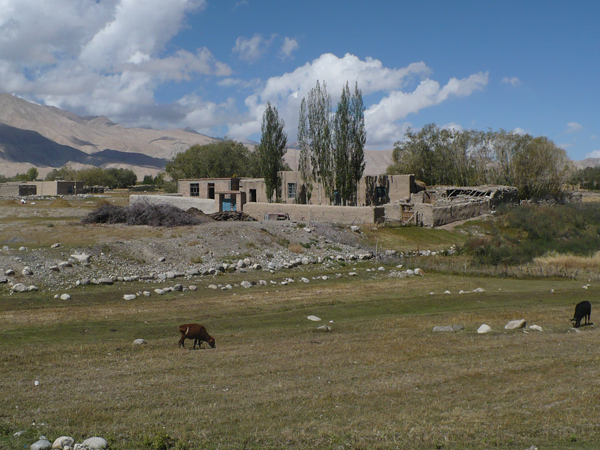 |
|
When Sazi was young, his family kept seventy sheep and more than thirty cows. Herding was a major part of his life then. |
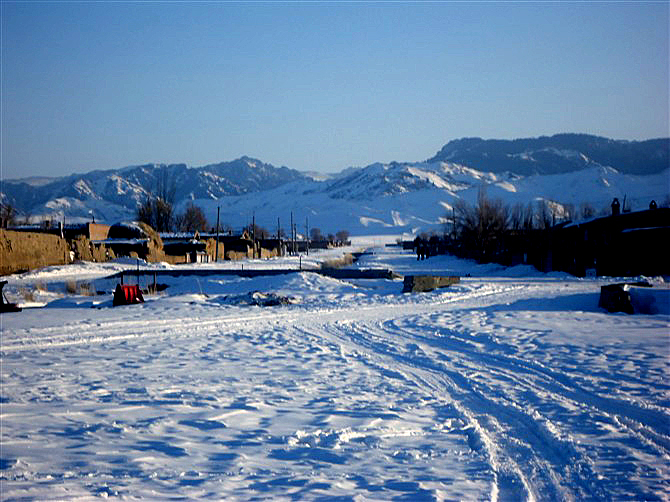 |
|
Sazi’s home was located at the foot of Tian Mountain, an extremely cold place as he remembers. The temperature there often dropped to 30℃ below zero. |
“Bearing” is a consistent strategy in Sazi’s artistic practice – he once carried a pile of bricks, which weighed the same as his wife, on his back, and wandered the streets and alleys of Songzhuang Artists’ Village to commemorate their relationship. Reflecting on the whole on the interrelationship between his works and life, Sazi believes that while the bricks only reflected one dimension of his personal experiences and might impose a compelling sense on the viewer, a tree, which is both commonly seen and of strong vitality, could represent his life with a stronger sense of integrity and spirituality. The choice of using a tree as his medium was also founded on the artist’s affinity with nature, which was established during his childhood spent in rural areas where he farmed and herded the sheep. “I hope to, especially after I came to Beijing, find a sense of belonging among the body, the earth, and the spirit.” In this way, the tree became an emblem of the story of Sazi’s life and his mentality. The artist thus projects onto his relationship with the three an autosuggestion of merging with nature. In one diary written around the 80th day of walking, Sazi wrote: “I seem to have forgotten the presence of the tree just like forgetting the existence of my body. Now the tree and I have become a whole. Among the crowd and in the Gobi, I would rather be a tree forever – simply being there.”
The tree that Sazi carried on his back was a Buxus microphylla. According to the artist, he had considered many factors when choosing this species. For example, the conditions required for the tree’s growth should not be too difficult to meet. In other words, the tree should be strong enough to tolerate drought and coldness. Also, it should not grow too fast as it would be impossible to carry it for long if it grew rapidly. Meanwhile, it should not be an expensive species so that it can symbolize the life of the bottom class. Buxus microphylla is a species commonly used for urban greenery in Beijing. One day, Sazi went out for exercise and saw someone planting them. He then stepped forward to ask for one tree and took it back to his studio, where he grew the tree for a month before transplanting it in a bucket when he was setting off for the journey. Sazi also made a special durable strap for the tree bucket. During the 133 days of the long walk, he watered the tree every day and kept it in a tent at night. At the end of the journey, he left the tree in a relative’s house outside the city of Urumqi. For his project has attracted too much attention, he is reluctant to reveal the exact location of the tree. In case that the tree is needed for exhibitions, he would replace it with other trees. He has made up his mind that the tree will eventually be planted in front of his grave.
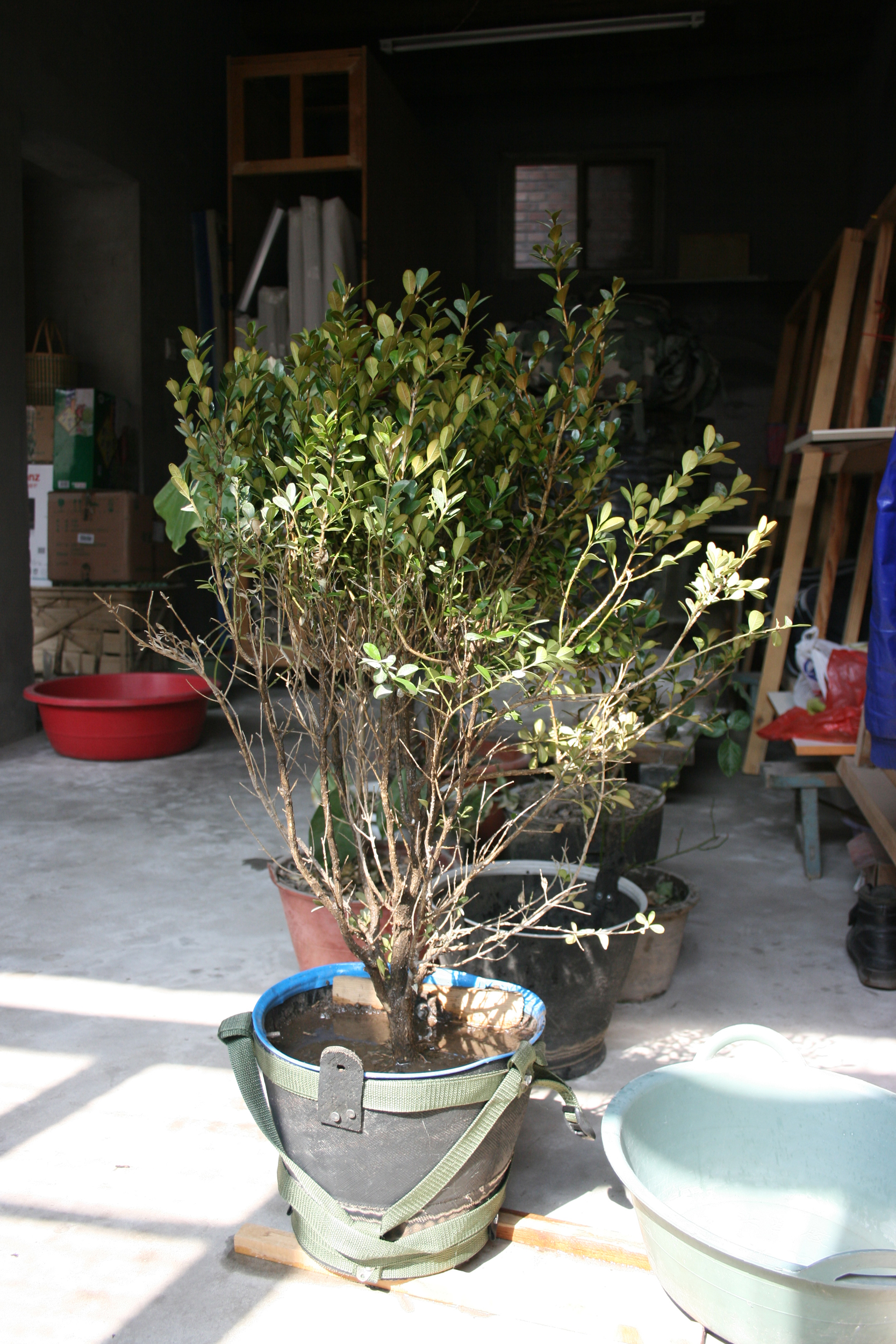 |
|
The tree in Sazi’s studio in Songzhuang before the journey began |
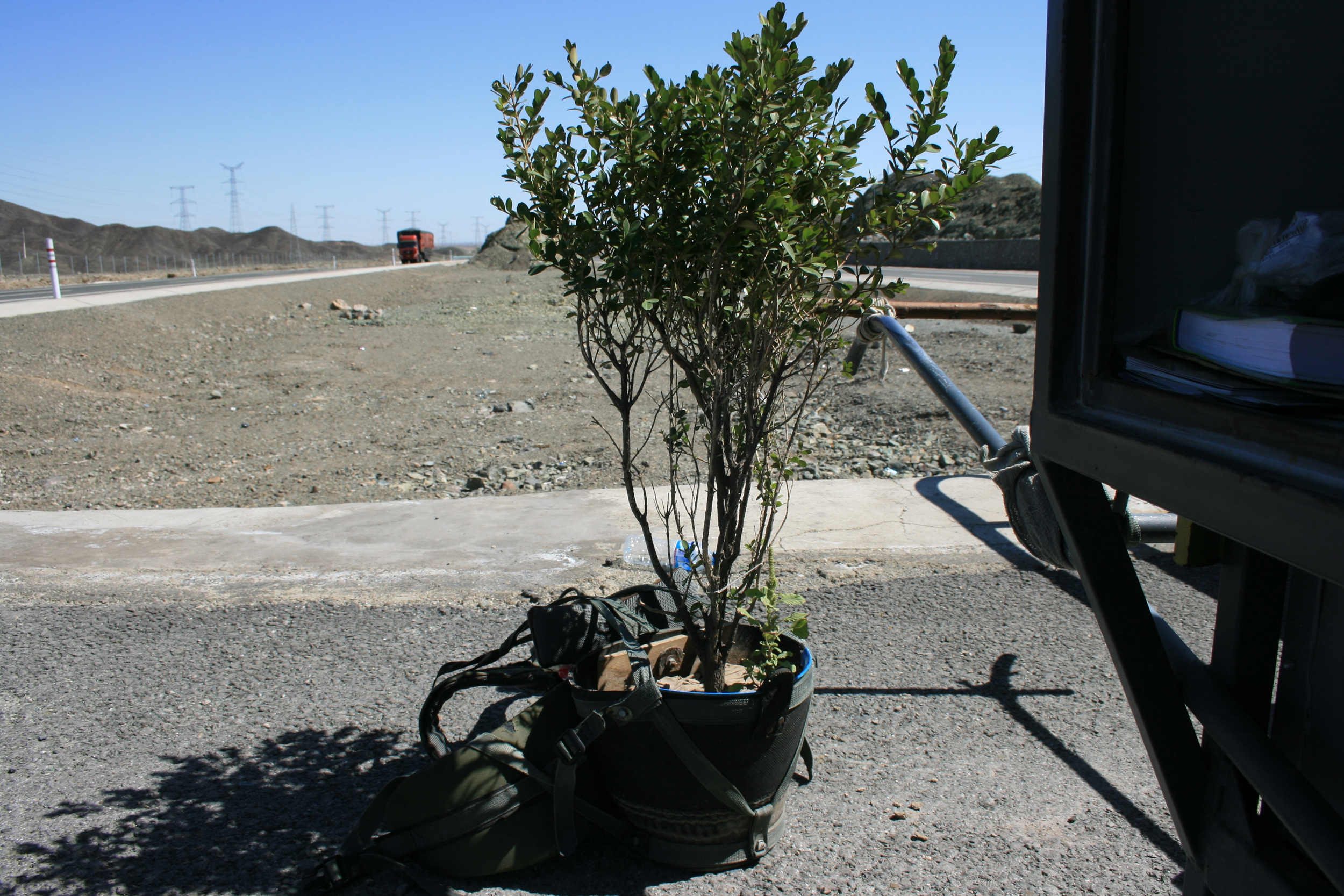 |
|
The tree when Sazi arrived in Guazhou County, Gansu Province |
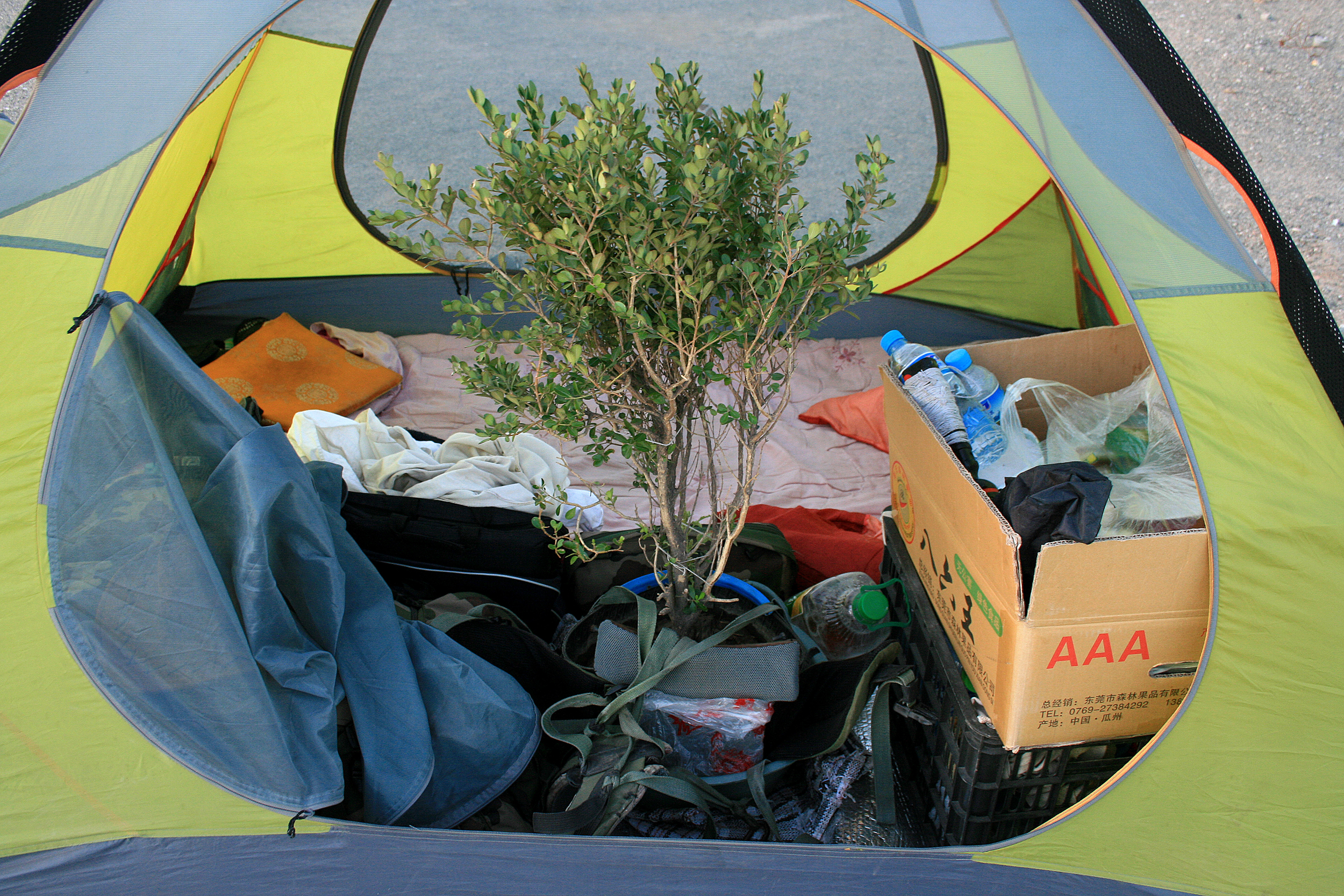 |
|
The tree was kept in a tent at night |
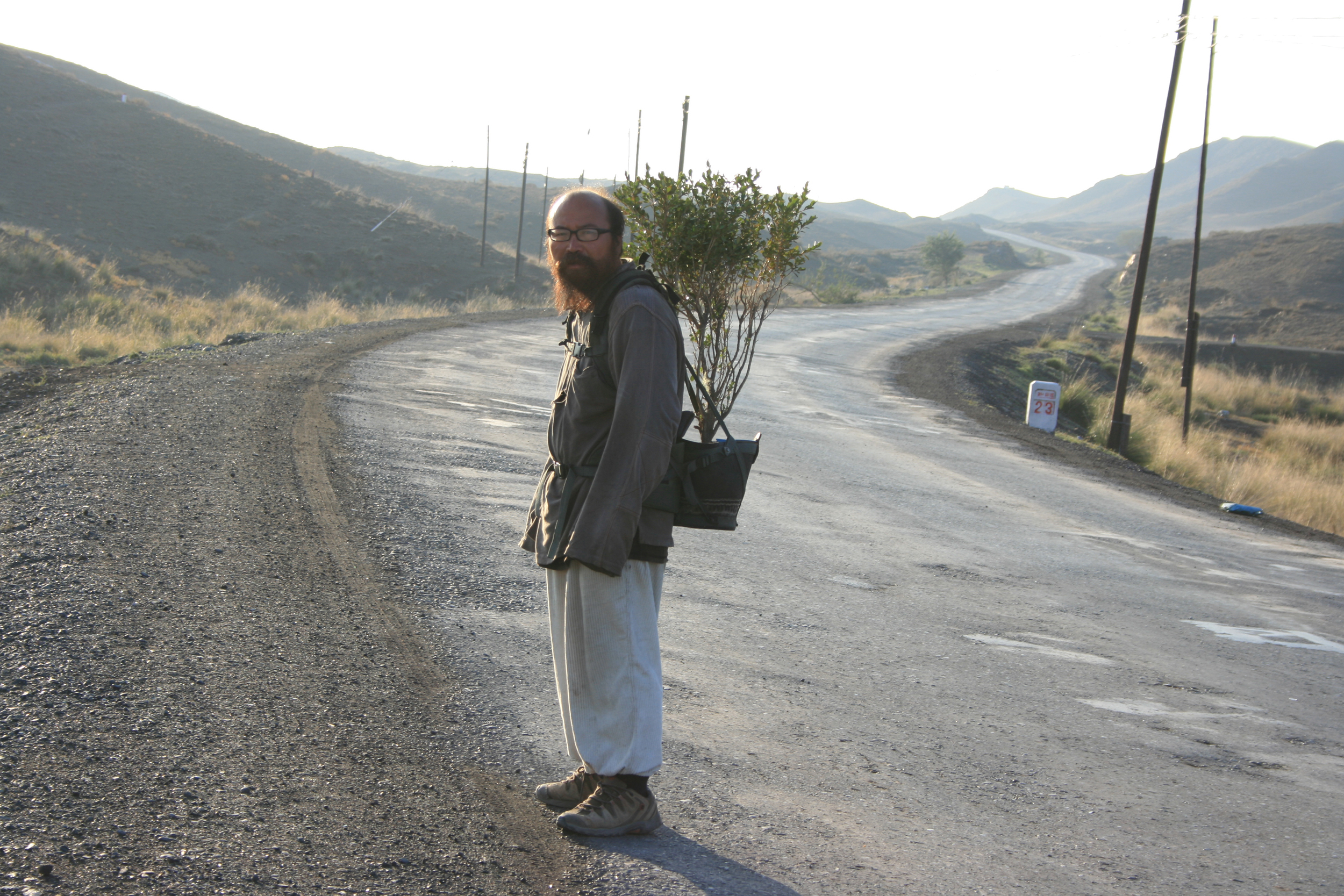 |
|
The last day of the journey. “Carry a tree on your back while travelling on foot, with clear goals, directions, and plans. Moreover, to do this is both a belief and a mission. Foremost, it is a compulsive plan that you must stick to and persistently execute. Meanwhile, the outdoor environment would change each day, thus bringing excitement and freshness that can be intriguing.” |
The natural environment makes Sazi feel at ease. However, nature can also be dangerous – in the Gobi, deserts, and wind zones, not only the weather is harsh, it is also necessary to watch out for beasts like wild wolves and prepare for the highly probable situation of running out of food in uninhabited zones. From May to September, and from spring to autumn, Sazi’s progress on the road was also constantly influenced by the weather and natural environment. When it was too hot, the road would begin to melt, thus making walking impossible at noon and in the afternoon. Under such circumstances, the artist and his assistant would get up early in the morning to walk about twenty kilometers, leaving the other half of the distance to be covered for the night. Thus, from Jiuquan, Gansu Province, to Hami of Xinjiang, Sazi traveled mostly at night. They carried small gas tanks and basic cooking utensils, living on the road like nomads. When the wind was strong, it could take several hours for them to simply cross a bridge. In the beginning, Sazi could not get used to this life in the wild, which made him fall sick over and over again in the first month. However, all these experiences could hardly be counted as difficulties since to explore the relationships between the artist himself and the outside environment was, essentially, part of the project.
Sazi had laid out the itinerary long before the journey. In the process of walking, he would adjust the plan according to his progress and based on consultations with the local people. “Though this is a plan that I made in advance, it is completely forgotten in the process of its completion … I was just walking without thinking anything more. In the beginning, there was a strong sense of distance and contestation between the body and the destination; in this way, the ‘ending point’ had engendered a conspicuous bodily reaction since the moment I set off – it was a yearning for arrival. I am not sure when, but I suddenly realized that the sense of the ‘ending point’ stopped to exist” The changes in the perception of walking also altered the artist’s conception of the project. At first, he would deliberately stop at tourist spots and other areas where there were obvious landmarks; meanwhile, he also held various plans and anticipations for the ways he would walk and record the process. Later, he no longer made plans so much and would even consciously avoid prominent landmarks. This probably indicates a greater significance of Sazi’s walking practice besides its physical intensity – the embrace of the unpredictability of the external environment and the self – in the current era when maps are readily available, and everything always seems predictable.
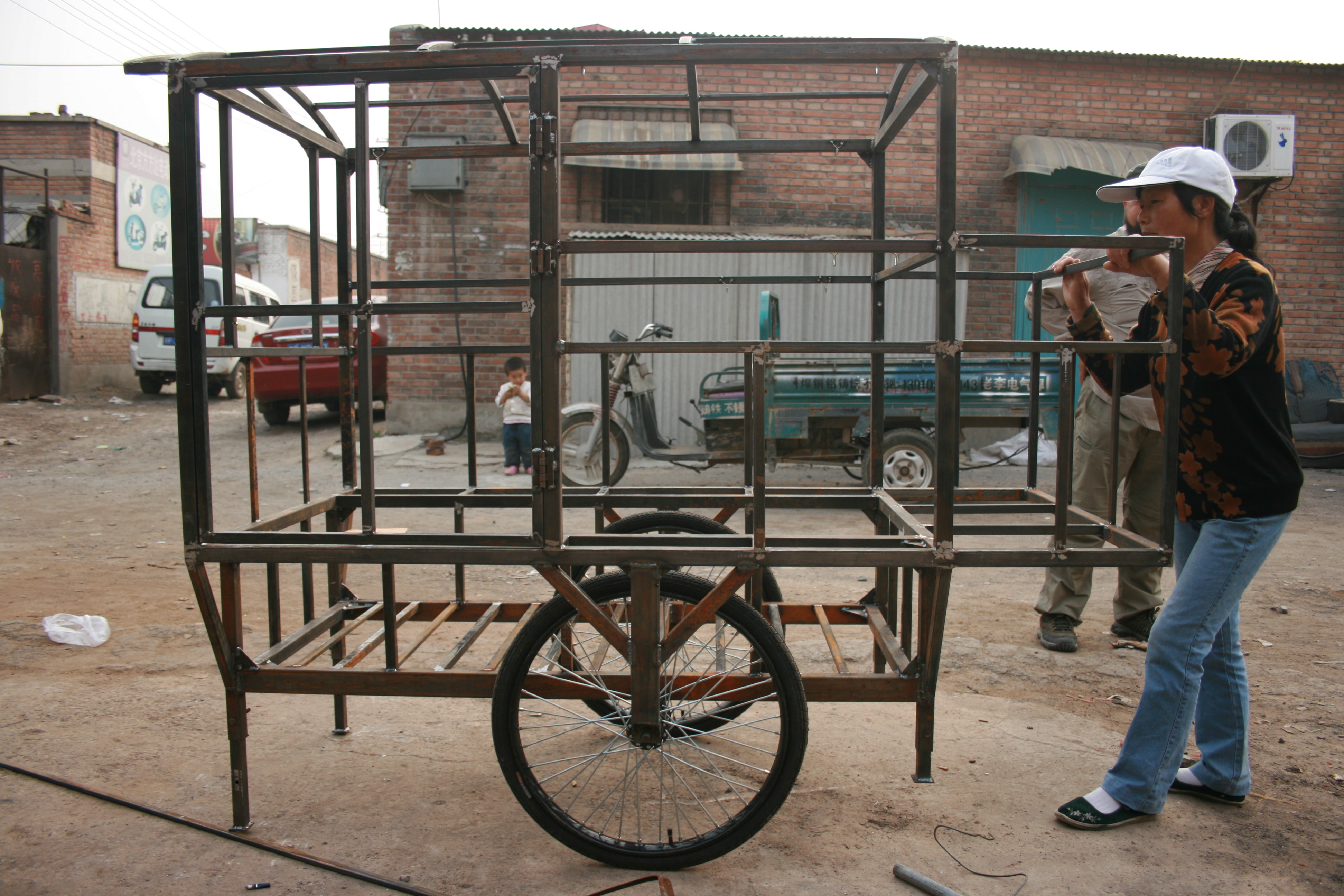 |
|
The structure of Sazi’s “caravan” |
 |
|
Sazi’s equipment was simple, including a tent, a custom caravan, and spare shoes, among other. The so-called “caravan” was indeed very crude, welded together by workers based on the rudimentary design made by Sazi and his friends. As many steel wires that dropped out of broken car tires were mixed in the gravels on the road, the bicycle tires used in the caravan needed repairment every two days, sometime even three time a day. |
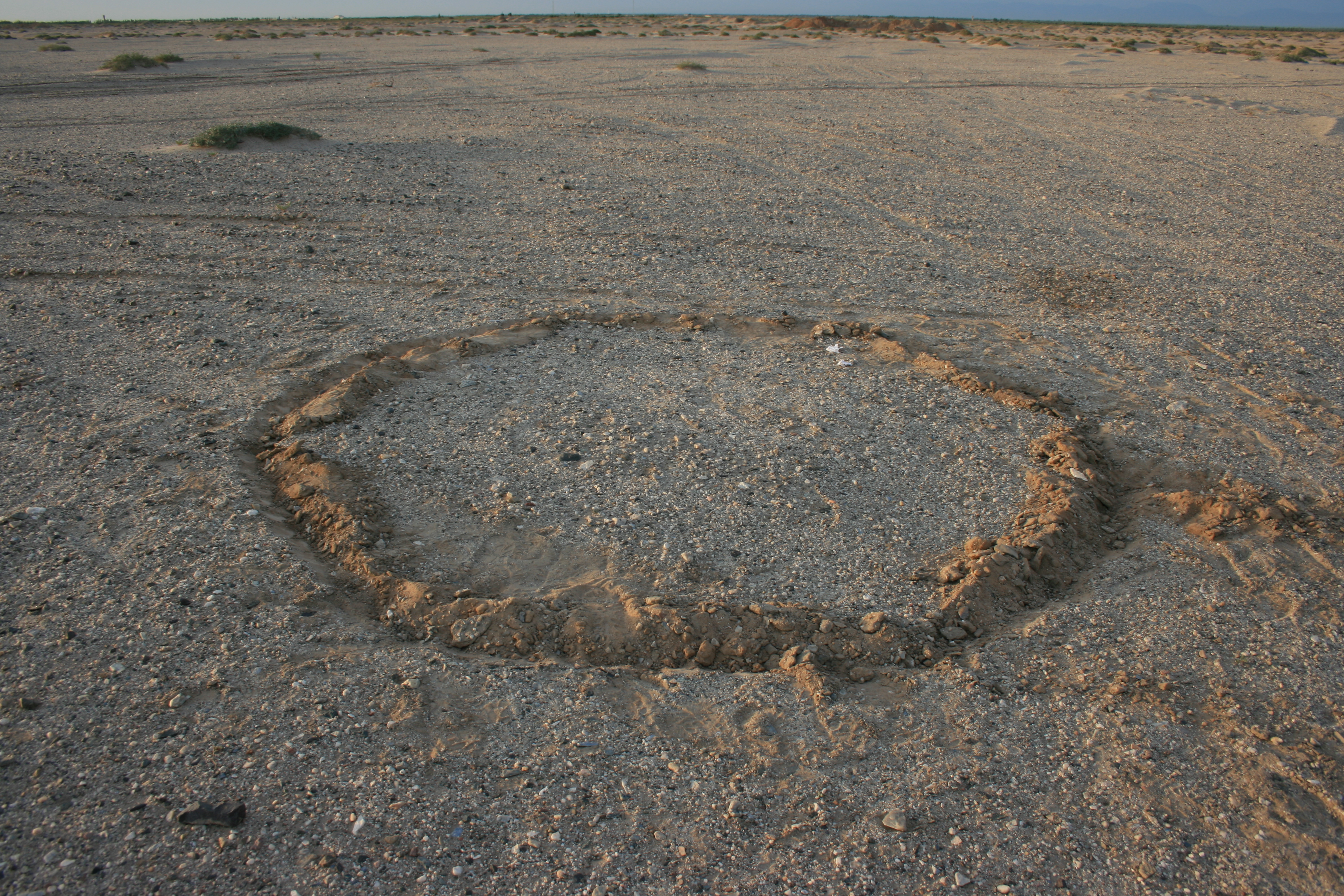 |
|
When camping in the Gobi Desert, one needs to dig small trenches to drain away the water. |
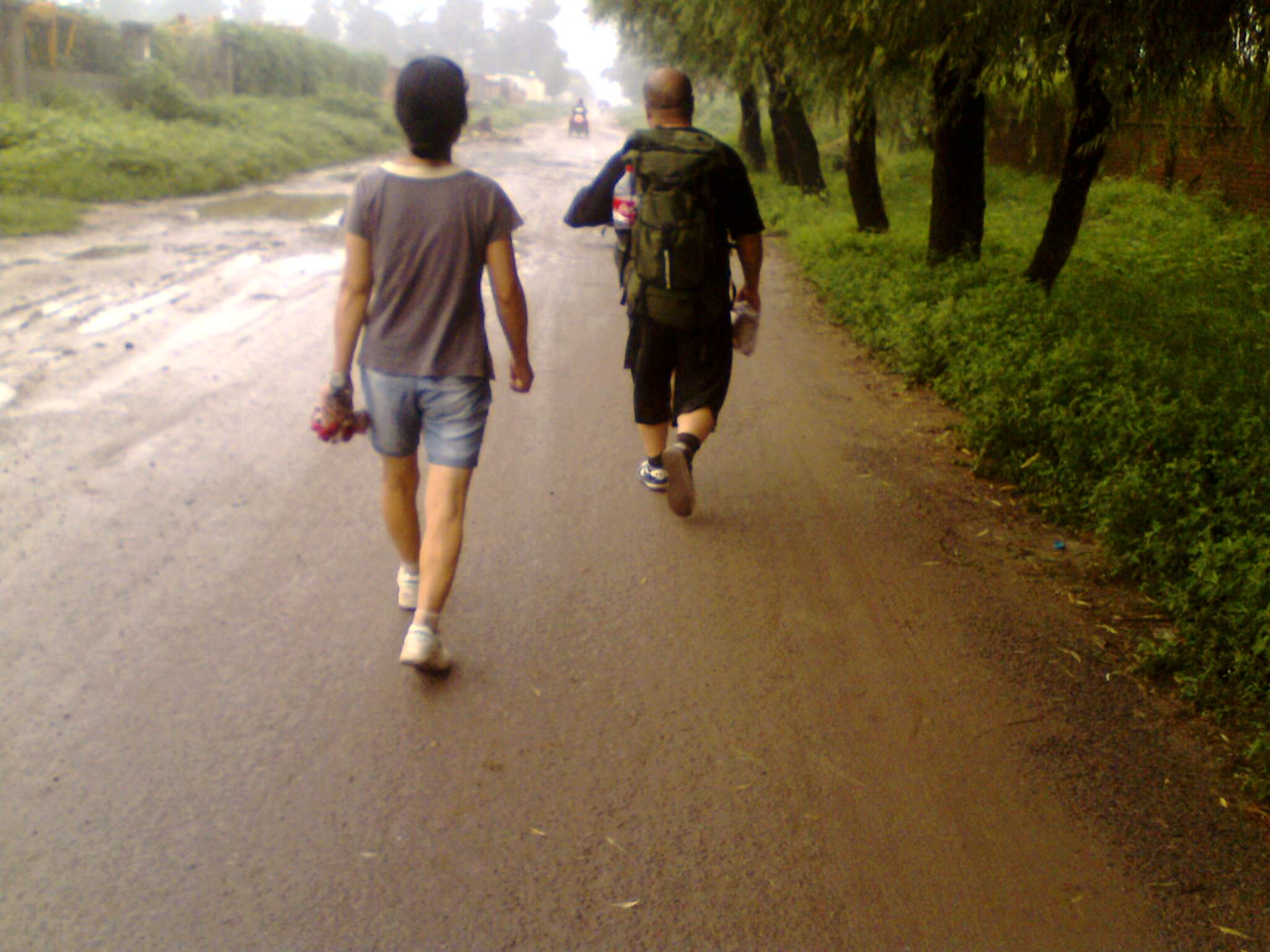 |
|
In June 2011, Sazi dug out a tree near the Shayukou Reservoir of Beijing. He planned to carry the tree around the city and plant it back to its original location (which would take fifteen days). However, on the fourth day, the artist was injured in the leg and could not walk on foot as usual, which brought the plan into failure. After that, the artist began a ten-month long preparatory exercise. He carried stones and rice (which weighed 40 kilograms) on his back and walked for more than three hours a day, covering twelve to thirty kilometers. During this 300 days of training, Sazi’s mother accompanied him every single day. |
 |
|
The pass prepared by Sazi for the journey |
Since Sazi could not charge the equipment all the time on the road, he documented the project mainly with photographs rather than videos to save the batteries. The photographs were taken both by the artist and his assistant. For the convenience of moving back and forth to capture the right scenes, the assistant first used a second-hand folding trolley before replacing it with a motorcycle. Sazi would not interfere with the assistant’s work. Each day on the road, the two focused on their own work. While Sazi carried the tree forward, the assistant would run back and forth to do the shooting. Only at night would they discuss together. The shooting equipment was simple – either it was a cell phone or a Canon 400D. In the beginning, the outcomes of the shooting were dissatisfactory: there were too many close-up shots so that the main character was hardly placed in a holistic representation of his surrounding environment. It took a while for them to better grasp the right way of shooting: “Taking this type of photos is different from taking photos for outdoor sports – one needs to capture the spirituality, authenticity, and the vivid characteristics of the actions.”
When Sazi conceptualized the plan for A Tree, he had the opportunity of receiving sponsorship of 200,000 yuan on the condition that he conducts the project in an official, propagandist way by taking a Buddhist missionary route and carrying a bodhi tree. Sazi turned down the offer and, instead, sold a few paintings to raise 30,000 yuan to go on the road by self-sponsorship. For Sazi, A Tree was a systematic review and cleanse of his art, life, and xiū xíng: “Human life is tragic in two inevitable aspects: one is infinite confusion, and the other is infinite consumption. Born in confusion, I also wandered through my youth without getting out of the confusion; yet, reaching middle age, I now feel that life is not completely hopeless – one needs to grow old sincerely and must not waste time on nonsense … (being) an artist is a process of self-salvation, and it needs concrete actions rather than simply abstract talks of stratagems.”
Image and video courtesy of the artist. All rights reserved.